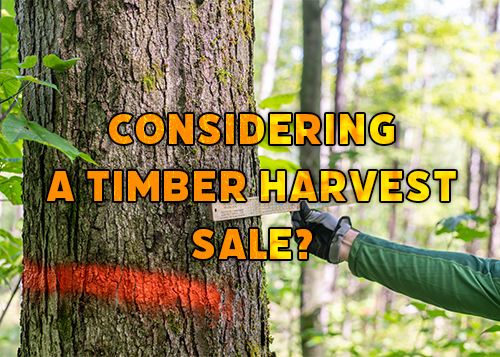North American hardwood forests offer an abundant variety and supply of hardwood species. From White Oak, Hard Maple, and Cherry to Walnut, hardwood forests are a sustainable source of beauty and resources.
 In fact, over the past 50 years, it is estimated that the volume of hardwoods in North American forests has actually increased 119% and over 65% of all hardwood forests in the United States are owned by private landowners. With that in mind, it should come as no surprise to hear that many private land owners are curious about having their timber harvested and may have many questions or concerns about how best to go about that process.
In fact, over the past 50 years, it is estimated that the volume of hardwoods in North American forests has actually increased 119% and over 65% of all hardwood forests in the United States are owned by private landowners. With that in mind, it should come as no surprise to hear that many private land owners are curious about having their timber harvested and may have many questions or concerns about how best to go about that process.
At Baillie, We realize our success starts in the forest and our entire forest management operation begins with the landowner. Virtually all of the hardwoods we saw, kiln-dry and sell originates from timber grown by private landowners. Because of that, proper forest management practices such as selective harvesting, single tree selection, etc. are crucial. Many times a landowner often only sees their property harvested once or twice in their lifetimes. That is why developing a solid plan is critical to meet your short term and long term goals, as well as reducing any wildlife and/or property disruption is so important.
So how can you properly prepare for a hardwood timber harvest? Based on our years of experience working with hardwood forest landowners here are a few thoughts we recommend taking into consideration for any landowner looking to harvest their hardwood lot.
Set a Meeting. The initial meeting with a forester is where you can discuss your goals, both in the long term and the short term. Take the time to jot down any questions, concerns, etc. that you may have. This could include your goals for tree selection, forest management, land restoration, wildlife management or any anything else you might have in mind.
Take a Walk in the Woods. Walking the property with the forester offers you the opportunity to properly explain and point out important items of importance for them to keep in mind. Things such as property lines, types of trees to be selected, or even areas that have specific meaning for you that you want protected. You can also discuss placement for log landings, skid roads, and proper clean up after. The more you communicate with the forester the better the end result.
Schedule a Timber Cruise. A timber cruise is the term used to explain an onsite visit of the property to mark, measure and value the standing timber to be harvested off the land so it is a good idea to request that the forester you choose conducts a formal timber cruise.
Request a Proposal. Sign a Contract. A written proposal that details the specifics of the harvest, the preparation required and the expected results is important. It is also a good idea to sign a timber sale agreement and include items such as the boundaries to be harvested, the timeframe of the project, the pricing methodology to be used, proper insurance to ensure you are protected, the expected condition the land will be restored to and who would be responsible for damages if any occur.
Logger Meet and Greet. Have the forester introduce you to the timber harvester (logger). This is a great time to review your expectations and the agreed upon expected pre-harvest preparations. Look over the log landing sites, the placement of skid roads, and any other post-harvest land restoration you expect to be completed as a part of your above mentioned contract.
Schedule a Post-harvest Review. When timber harvest is complete conduct a post-harvest review of your property. When doing so make sure the job was completed properly and the terms of the timber sale agreement were fulfilled. This is a great time to discuss with your forester a game plan for future timber harvests.
If you are a land owner and are interested in harvesting the hardwood timber on their land following these six simple steps will increase your chances of achieving your harvesting goals.
Interested in learning more? The professional foresters within the Baillie Group are commitment to help you, the forest landowner.
Contact us today to speak with one of our professional foresters and let us know how we can help you meet your goals!
The Baillie Group

